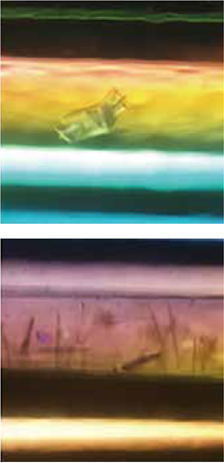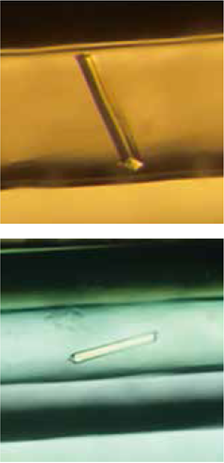This is an archive of information released in the past.
Disclaimer: It may contain broken links or outdated information. Some parts may not function in current web browsers.
*Visit https://humans-in-space.jaxa.jp/en/ for the latest information.

Experiment
- News
- Kibo Utilization Strategy
- Kibo Utilization Plan
- List of JAXA's Utilization Themes
- Experiment Facilities
- Space Environment Utilization
- Archive
Protein crystals produced on "Kibo" contribute to discovery of a compound that may lead to development of a new type of antibacterial drug such as curative drug for periodontal disease
A Japanese research team has found a compound that inhibits growth of periodontal disease bacteria, using the results of an ongoing protein crystal growth experiment on the Japanese Experiment Module (JEM) "Kibo". The team members are Dr. Yasumitsu Sakamoto, associate professor at Iwate Medical University, Dr. Mizuki Sekiya, assistant professor at Iwate Medical University, Dr. Nobutada Tanaka, associate professor at Showa University, Dr. Hiroaki Gouda, professor at Showa University, Dr. Wataru Ogasawara, professor at Nagaoka University of Technology, Dr. Yoshiyuki Suzuki, special associate professor at National Institute of Technology (KOSEN), Nagaoka College and Dr. Mitsugu Yamada, associate senior researcher at JAXA. This compound does not act on E. coli, a microorganism that use sugar to grow, but intensely act on periodontal disease bacteria, which do not use sugar as nutrient. It is expected that the discovery will lead to development of unprecedented antibacterial drugs that specifically target on non-fermenting gram-negative rods (NFGNR).
The research team had pursued a method to cut off the nutritional sources specific to NFGNR as a definitive treatment against the spread of infectious diseases caused by NFGNR. In the course of a space experiment in 2015, the team determined the structure of dipeptidyl aminopeptidase 11 ("DPP11"), an enzyme that is important for the growth of pathogen causing periodontal disease.*1 After structural determination of DPP11, the team searched for compounds that inhibit the function of DPP 11, and have an antibacterial effect in the following steps: first, based on the precise structure of DPP11 obtained from space grown crystals, 14,676 candidates were selected by searching from a database of 4 million compounds; second, the binding modes of DPP11 with these compounds were analyzed and 13 compounds were chosen; and then, inhibition against DPP11 of these compounds were assayed. Compound "SH-5" was found to have a selective antibacterial effect on periodontal disease bacteria. The structure of DPP11 and SH-5 complex obtained from the crystal grown on "Kibo" during an experiment in 2016 (Fig 1.) showed how they interact with each other (Fig 2.).
The team's achievements are a good example of the advantages of the ISS microgravity environment. It contributed to a series of research activities, starting from the determination of the precise structure of the target protein, and then verifying the bindings of drug candidates. The team describes in the article that the high-resolution data obtained from crystals produced in space are extremely useful for drug development.
The research team will soon start preparations for preclinical animal studies, aiming at developing medicinal drugs including compound SH-5. It is expected to contribute to development of drugs for periodontal disease and antibacterial drugs effective on multidrug-resistant organisms working in similar mechanisms to the periodontal disease bacteria.


Fig 1. Protein crystals produced on the ground (left) and in space (right) (Credit: Iwate Medical University/JAXA)



Fig 2. Data obtained from space grown crystals were used in the research processes (Credit: Iwate Medical University/Showa University)
Left: 3D structure data obtained from the high-quality crystal of DPP11 grown on "Kibo" were used to identify chemical data of compounds that may bind to DPP11.
Center: Screening and computer docking simulations based on the precise DPP11 structure from a commercially available compound database.
Right: Binding mode was verified from space grown high-quality crystals of a complex of DPP11 and the lead compound "SH-5"p.
Article information
The research achievements were published in Scientific Reports, a scientific journal
Journal:Scientific Reports
Article:Fragment-based discovery of the first nonpeptidyl inhibitor of an S46 family peptidase
*All times are Japan Standard Time (JST)
| Copyright 2007 Japan Aerospace Exploration Agency | Site Policy |